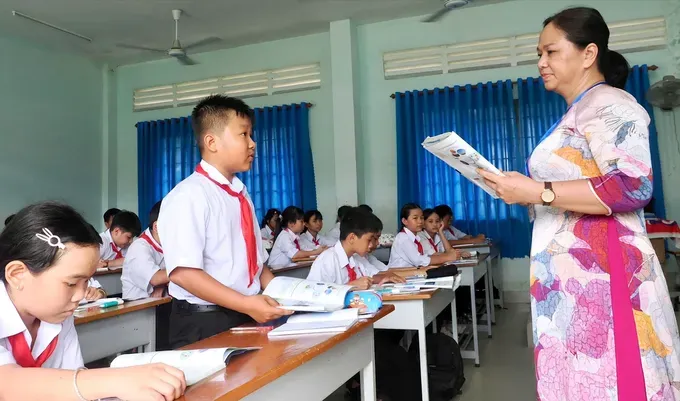One of the main reasons many students in Vietnam’s border communes drop out or discontinue their studies is the shortage of semi-boarding and boarding schools. This lack of facilities makes teaching and learning especially difficult under harsh weather conditions.

Determination to learn for a better future
Fifth grader Le Nhat Tien in Thuong Phuoc, a border commune of Dong Thap Province, revealed that he walks more than five kilometers to class every day. In the rainy season, the road turns muddy; during the floods, he wades through water to get to school.
Nguyen Thanh Hung, another fifth grader, carries a heavy backpack daily because his classroom lacks storage cabinets. “It’s tiring going to school from so far away and lacking so many things, but my father always tells me to study hard to escape poverty,” he said quietly.
Principal Nguyen Van Thinh of Thuong Thoi Tien 1 Primary School explained that the school has only 19 classrooms for 24 classes, lacks functional rooms and teaching equipment, and cannot organize semi-boarding lunches, forcing students to attend only half-day sessions. “We have more than 700 teachers and students but only two toilets. The schoolyard floods in the rain and fills with dust in the sun. We just hope for a new school so our children can study properly,” he said earnestly.
In Tay Ninh Province, which shares the longest border with Cambodia in the Mekong Delta region, many schools near the border remain in poor condition. Each morning, sixth grader Truong Hoai Dang at Le Duan Secondary School, and his sister Truong Thi Tra Mi, a tenth grader at Le Hong Phong High School, wake up at 5 a.m. to help their mother sort and count lottery tickets before traveling nearly ten kilometers on an old, makeshift three-wheeled motorbike to reach school.
Despite the hardships, optimism never fades from the face of their mother, Dao Thi Lien, a lottery ticket seller. She said that if she sells all her tickets each day, she earns about VND130,000. Life is hard, but she is happiest that her children are determined to keep studying. Therefore, she hopes the schools can be rebuilt soon and have boarding facilities.
Principal Vo Van Hai of Le Duan Secondary School noted that out of 708 students, around 10 percent come from poor or near-poor households, with many at risk of dropping out. Since the July 2025 administrative merger, Ninh Dien Commune has grown to 11 hamlets with a population of about 30,000 and a total area of 292.07 square kilometers. However, with the large, dispersed population and insufficient school infrastructure for semi-boarding arrangements, students from low-income families who live far from school remain especially vulnerable to leaving school early.
Improving boarding policies
While teachers and students in provinces and cities of the Mekong Delta region wish for semi-boarding schools, in many other border communes, semi-boarding schools are also taking on the role of boarding schools.
Principal Luc Thi Luong of Coc Pang Ethnic Minority Semi-Boarding Primary School in Cao Bang Province’s Coc Pang Commune said that although it is a semi-boarding school, 78 out of 360 students from grades 1 to 5 must board at school because their homes are too far away, while the school has no official boarding policy for either students or teachers. Nevertheless, with determination and dedication to help the children study well, 16 teachers stay in government housing or rent near the school to clean and prepare three meals a day for the students.
In northern provinces such as Tuyen Quang, Lao Cai, Lai Chau, Dien Bien, and Son La, many border-area schools face similar circumstances to Coc Pang Ethnic Minority Semi-Boarding Primary School, simultaneously maintaining both semi-boarding and boarding models. Among them, most primary schools, lower secondary schools, and combined primary–lower secondary schools operate only under the semi-boarding model. However, in communes where the population is scattered and transportation is difficult, students stay at school to live and study five days a week, returning home only on weekends.
The way of organizing daily life, meals, and accommodations for students, as well as the responsibilities of teachers and administrators in semi-boarding schools, is no different from boarding schools. However, conditions for boarding areas, dining halls, and clean water in many schools remain rudimentary, with some schools having to use classrooms as makeshift dormitories.
Allowances for teachers in charge of semi-boarding students remain low, and many teachers work under contract arrangements. Therefore, most border-area schools share the desire to have infrastructure upgraded so they can become official boarding schools.
According to the Ministry of Education and Training, more than 273,000 students nationwide, or 43.7 percent of the country’s total number, are in need but have not yet been able to study at boarding or semi-boarding schools. These students, though needing to stay at school during the week for study and daily life, still have to cross mountain passes, endure floods, or walk across makeshift suspension bridges to reach school each day. In reality, many must stay at school or rent accommodation near school because they cannot commute daily due to the rugged, divided terrain.
Therefore, the Ministry of Education and Training has proposed that the Government, during the 2025–2027 period, invest in building new and renovating existing boarding schools in 248 communes, with facilities that fully and comprehensively meet the needs of students and teachers for both boarding and semi-boarding. The main source of construction funding will come from the central budget, supplemented by local budgets and other lawful resources.
At the same time, regulations will be improved to ensure that students in border communes benefit from boarding and semi-boarding policies suited to the difficult realities of terrain and distance; that appropriate teacher assignments are made; and that budgets are secured to maintain school operations and provide proper benefits for teachers under the new conditions.
























